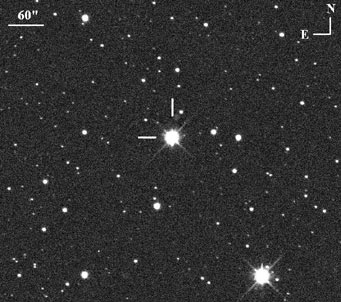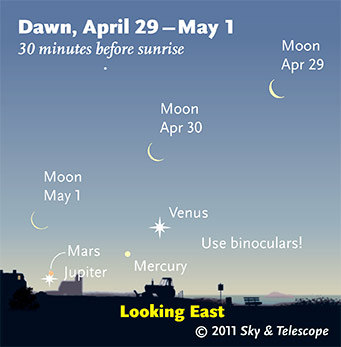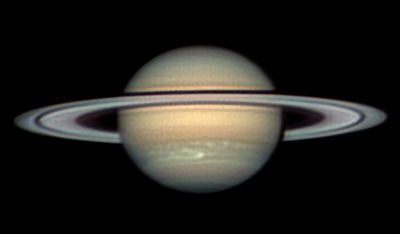
T Pyxidis in outburst on April 15th, the day after its discovery. North is up. See before-and-after animation (with south up).
Ernesto Guido and Giovanni Sostero
The recurrent nova T Pyxidis erupted last week for the first time since December 1966. It's now magnitude 7.5 (as of April 22nd) and is likely to brighten to about 6.4 by May 20th. It's visible right after dark from mid-northern latitudes and points south. See our article T Pyxidis Finally Blows Again.
Friday, April 22
Saturday, April 23
Sunday, April 24
Monday, April 25
Tuesday, April 26
Wednesday, April 27

Before sunrise as April ends, the waning crescent Moon guides the way to four planets on the down-low. One should be easy to spot; the other three are a real challenge. (The visibility of the fainter objects in bright twilight is exaggerated here. These scenes are drawn for the middle of North America. European observers: move each Moon symbol a quarter of the way toward the one for the previous date.)
Sky & Telescope diagram
Thursday, April 28
Friday, April 29
Saturday, April 30
Want to become a better amateur astronomer? Learn your way around the constellations. They're the key to locating everything fainter and deeper to hunt with binoculars or a telescope.
For an easy-to-use constellation guide covering the whole evening sky, use the big monthly map in the center of each issue of Sky & Telescope, the essential magazine of astronomy. Or download our free Getting Started in Astronomy booklet (which only has bimonthly maps).
Sky Atlas 2000.0 (the color Deluxe Edition is shown here) plots 81,312 stars to magnitude 8.5. That includes most of the stars that you can see in a good finderscope, and typically one or two stars that will fall within a 50× telescope's field of view wherever you point. About 2,700 deep-sky objects to hunt are plotted among the stars.
Alan MacRobert
Once you get a telescope, to put it to good use you must have a detailed, large-scale sky atlas (set of charts). The standards are the Pocket Sky Atlas, which shows stars to magnitude 7.6; the larger Sky Atlas 2000.0 (stars to magnitude 8.5); and the even larger and deeper Uranometria 2000.0 (stars to magnitude 9.75). And read how to use sky charts effectively.
You'll also want a good deep-sky guidebook, such as Sky Atlas 2000.0 Companion by Strong and Sinnott, or the more detailed and descriptive Night Sky Observer's Guide by Kepple and Sanner, or the classic if dated Burnham's Celestial Handbook.
Can a computerized telescope take their place? I don't think so — not for beginners, anyway, and especially not on mounts that are less than top-quality mechanically. As Terence Dickinson and Alan Dyer say in their Backyard Astronomer's Guide, "A full appreciation of the universe cannot come without developing the skills to find things in the sky and understanding how the sky works. This knowledge comes only by spending time under the stars with star maps in hand."
This Week's Planet Roundup
Mercury, Venus, Mars, and Jupiter are deep in the bright glow of dawn. Venus is the least low and by far the brightest. Use binoculars 20 or 30 minutes before sunrise to look lower left of Venus for Mercury, which is fading daily. Farther lower left is tiny Mars, even fainter. And farther lower left still is Jupiter. Jupiter becomes a little higher and less difficult each morning; it will pass Mars on May 1st.

Saturn's white spot has erupted again! The head of the pale streamer wrapping around the planet has brightened up, as seen in this image taken by Christopher Go on April 26th (at 12:54 UT; System III central-meridian longitude 274°). Compare with Go's images of the area one day earlier (scroll down to "April 25").
Also see his animation there of several images confirming dark spokes on the left (celestial west) side of the bright B ring on April 25th. On his website images are north up.
Saturn (magnitude +0.5, in Virgo) is the only planet anywhere in good view now. Look for it glowing in the southeast as the stars come out, with Spica down below it and bright Arcturus far to its left. Saturn rises higher in the southeast after dark and shines highest in the south around 11 or midnight daylight saving time.
In a telescope, Saturn's rings have narrowed slightly in the last few months to 8° from edge on. See how many of Saturn's satellites you can identify in your scope using our Saturn's Moons tracker. Saturn's months-old northern-hemisphere white spot has spread into a faded, double light band all the way around the planet.
Only about 2° from Saturn is fainter Gamma Virginis (Porrima), a fine, close telescopic binary star with a current separation of 1.7 arcseconds. Use high power, and hope for good seeing. See article in the April Sky & Telescope, page 56.
Uranus is deep in the dawn, in the background of Venus but too faint to see.
Neptune (magnitude 7.9, in Aquarius) is low in the east-southeast just before dawn's first light.
All descriptions that relate to your horizon — including the words up, down, right, and left — are written for the world's mid-northern latitudes. Descriptions that also depend on longitude (mainly Moon positions) are for North America. Eastern Daylight Time (EDT) equals Universal Time (also known as UT, UTC, or GMT) minus 4 hours.
To be sure to get the current Sky at a Glance, bookmark this URL:
http://SkyandTelescope.com/observing/ataglance?1=1
If pictures fail to load, refresh the page. If they still fail to load, change the 1 at the end of the URL to any other character and try again.
 0
0
Comments
You must be logged in to post a comment.